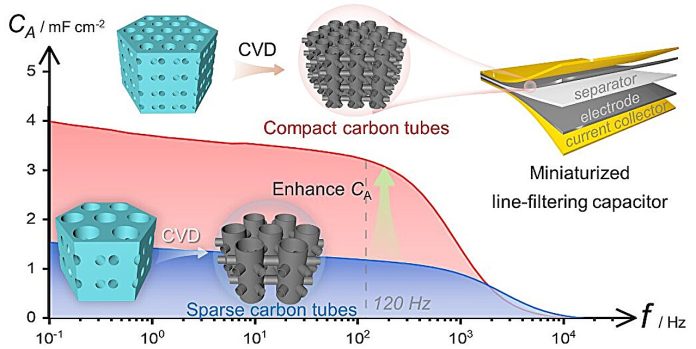
A team of researchers has created high-density three-dimensional carbon tube nanoarray electrodes for use in line-filtering capacitors, showing great potential for high-performance, miniaturized filter devices.
Their findings were published in Nano-Micro Letters.
Filter capacitors are crucial for converting fluctuating voltage signals into steady direct current.
Traditionally, aluminum electrolytic capacitors (AECs) are used, but they are large and have limited capacitance, making it challenging to downsize modern electronics.
Electric double-layer capacitors (EDLCs) offer much higher energy density and are promising for smaller filter capacitor applications.
However, traditional carbon-based EDLCs face slow ion transport, making it hard to achieve both high energy density and quick frequency response needed for line-filtering.
Led by Professors Meng Guowen and Han Fangming from the Hefei Institutes of Physical Science, along with Professors Wei Bingqing from the University of Delaware and Li Xiaoyan from Tsinghua University, the research team focused on manipulating the pore structure of three-dimensional interconnected porous anodized aluminum oxide (3D-AAO) templates.
They successfully tuned the vertical pore diameter of 3D-AAO from 70 to 250 nanometers and the inter-pore spacing from 100 to 450 nanometers.
Using these templates, they fabricated 3D compactly arranged carbon tube (3D-CACT) nanoarray electrodes through chemical vapor deposition.
Tests showed that reducing both pore diameter and inter-spacing significantly increased the electrode’s surface area.
The new 3D-CACT electrode-based device showed exceptional frequency response performance, with a phase angle of -80.2° at 120 Hz, an ultra-low equivalent series resistance of less than 0.07 Ω cm², and a rapid resistance-capacitance time constant of 0.25 milliseconds.
Its specific areal capacitance at 120 Hz reached 3.23 millifarads per square centimeter, far surpassing commercial AECs (~0.08 mF cm²) and previously reported aqueous sandwich-type line-filtering EDLCs.
This indicates the 3D-CACT nanoarray’s ability to facilitate efficient ion transport and provide ample charge adsorption sites.
The researchers also demonstrated the scalability of their approach by connecting six and ten sets of identical 3D-CACT-based EDLCs in series, extending the capacitors’ operating voltage while maintaining rapid frequency response and low loss characteristics.
To prove their invention’s practicality, they used ten series-connected devices as filters to convert various alternating current inputs (including sinusoidal, square, triangular, noisy waves, and pulsed signals from a rotating triboelectric nanogenerator) into smooth direct current signals, with performance comparable to commercial AECs.
“The high-density 3D-CT nanoarray electrodes offer promising solutions for high-performance filter capacitors, advancing miniaturized power systems and electronics,” said Professor Meng. “This method enables size customization of nanomaterials and promotes the development of innovative integrable microdevices.”



